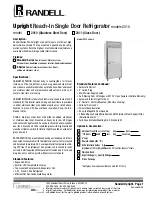
5
Normal Operating Sounds
•
You may hear faint gurgling or bubbling sounds
when the refrigerant is pumped through the coils or
tubing at the rear, to the cooling plate/evaporator.
•
When the compressor is on, the refrigerant is being
pumped round, and you will hear a whirring sound
or pulsating noise from the compressor.
•
A thermostat controls the compressor, and you will
hear a faint ’click’ when the thermostat cuts in and
out.
Fresh food refrigeration
To obtain the best performance, do not store warm
food or evaporating liquids in the refrigerator; do
cover or wrap the food, particularly if it has a strong
flavour.
Do not cover the shelves with any protective
material, such as paper, cardboard or plastic, which
may obstruct the air circulation through them.
To help you use your refrigerator correctly, here are
some more useful hints:
Raw meat (beef, pork, lamb & poultry or chicken):
wrap in polythene bags and place on the glass shelf
above the salad crispers.
Meat can only be stored safely in this way for
one or two days at the most.
Fruit & vegetables: these should be thoroughly
cleaned and placed in the bottom salad crispers.
Butter & cheese: these should be placed in special
airtight containers or wrapped in aluminium foil or
polythene bags to exclude as much air as possible.
Milk bottles: these should have a cap and should be
stored in the bottle rack on the door.
Movable shelves
The walls of the refrigerator have runners so that
shelves can be positioned as desired.
Positioning the door shelves
To permit storage of food packages of various sizes,
the door shelves can be adjusted in height.
To do this proceed as shown in the diagram.
D758
D040
Food Storage
•
To obtain the best results from the appliance
neither hot foods nor liquids which may evaporate,
should be placed in the larder compartment.
•
Keep the time between buying chilled food and
placing it in your refrigerator as short as possible.
•
Do not push food together too much, try to allow air
to circulate around each item.
•
Do not store food uncovered.
•
Remove suspect food from your refrigerator and
clean, refer to Maintenance and Cleaning.
Energy Saving Advice
•
Do not install the appliance close to sources of
heat, such as a boiler or radiator.
•
Locate the appliance in a cool well ventilated room
and make sure that the air openings of the
appliance are not obstructed.
•
Always leave warm food to cool down to room
temperature before placing in the fridge.
•
Try to avoid keeping the door open for long periods
or opening the door too frequently as warm air will
enter the cabinet and cause the compressor to
switch on unnecessarily often.
•
Ensure there are no obstructions preventing the
door from closing properly.
•
It is advisable to peridocally clean the refrigeration
system at the back of the appliance with a duster or
vacuum cleaner.
HINTS AND TIPS
8
INSTALLATION
Positioning
This appliance is designed to operate in ambient
temperatures between 10°C (50°F) and 32°C (90°F).
It should be located in a dry atmosphere, out of
direct sunlight and away from extreme temperature
e.g. not next to a boiler or radiator, or in a very cold
room e.g. an outhouse, where the temperatures may
fall below 10°C (50°F). If these temperatures are
exceeded i.e. colder or warmer, then the appliance
may not operate correctly.
You should also ensure that air can circulate freely
around the back and the top of the cabinet. There
must also be at least 100 mm (4”) distance between
the top of the cabinet and any overhanging kitchen
furniture (A). Ideally, the appliance should not be
positioned beneath overhanging furniture (B).
Important
IF YOU ARE DISCARDING AN OLD APPLIANCE
THAT HAS A LOCK OR CATCH ON THE DOOR,
YOU MUST ENSURE THAT IT IS MADE
UNUSABLE TO PREVENT YOUNG CHILDREN
BEING TRAPPED INSIDE.
Depending upon the position which you choose for
your appliance, you may wish to reverse the way in
which the door opens. To do this, refer to instructions
on “Door reversal”.
Please ensure that when the appliance is
installed it is easily accessible for the engineer in
the event of a breakdown.
TECHNICAL SPECIFICATIONS
DIMENSIONS
Height
124 cm
Width
55 cm
Depth
60 cm
POWER SUPPLY VOLTAGE AND FREQUENCY
220-240 V / 50 Hz
TOTAL POWER ABSORBED
110 W
AVERAGE DAILY UNITS ELECTRICITY *
0.55 kWh
GROSS CAPACITY
235 l
NET CAPACITY
230 l
* This figure is based on standard test results in accordance with European Standard EN 153.
Actual consumption will depend on how the appliance is used and where it is located.
D200
100 mm
10 mm
10 mm
A
B
NP007
There should also be a gap of 25 mm either side of
the appliance. Do not obstruct the space
underneath. The back of the cabinet may be placed
close to the wall but must not touch it. DO NOT
install in places with restricted ventilation.
Adjust the level of the appliance by screwing out the
adjustable foot, or feet, at the bottom of the cabinet
using your fingers.
























